Pierre-Claude Lépine (Raguet-) French, 1753-1810
Further images
-
(View a larger image of thumbnail 1
)
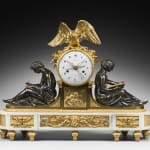
-
(View a larger image of thumbnail 2
)
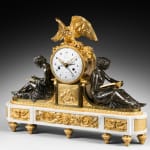
-
(View a larger image of thumbnail 3
)
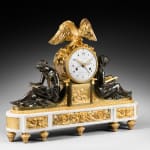
-
(View a larger image of thumbnail 4
)

-
(View a larger image of thumbnail 5
)
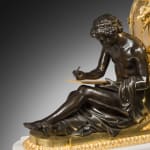
-
(View a larger image of thumbnail 6
)
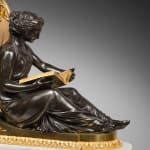
-
(View a larger image of thumbnail 7
)

-
(View a larger image of thumbnail 8
)

Literature
Cedric Jagger, “Royal Clocks”, 1983, pp. 154 and 155, illustrating similar clock cases with movements by Lépine and Nicholas Sotiau, in the British Royal Collection.
Hans Ottomeyer and Peter Pröschel, “Vergoldete Bronzen”, 1986, p. 295, pl. 4.17.5, illustrating a design for a similar case of 1784-85 from the Catalogue of François Rémond, and pl. 4.17.6, illustrating an identical clock with case by Rémond.
M. and Y. Gay, “Du Pont d’Iéna à l’Elysée”, in “Bulletin de l’Association Nationale des Collectionneurs et Amateurs d’Horlogerie Ancienne (ANCAHA), summer 1993, no. 67, p. 12, illustrating another comparable clock in the Salon des Aides de Camp in the Elysée Palace.
M. and Y. Gay, “La Banque de France”, in Bulletin ANCAHA, summer 1995, no. 73, p.76, illustrating a similar clock in the Banque de France, Paris.
Jean-Dominique Augarde, “Les Ouvriers du Temps”, 1996, p. 206, pl. 168, illustrating a very similar clock with case by Rémond, signed on the dial à Paris.
A. Gonzales-Palacios, “Il Patrimonio Artistico del Quirinale, Gli Arredi Francesi”, 1996, p. 308, no. 89, illustrating a comparable clock in the Quirinal Palace, Rome, signed on the dial Dubuc jeune.
Pierre Kjellberg, “Encyclopédie de la Pendule Française du Moyen Age au XXe Siècle”, 1997, pp. 260 and 261, illustrating two clocks of the same model both with dials by the enamellist Dubuisson.
Elke Niehüser, “Die Französische Bronzeuhr”, 1997, p. 86, pl. 134, illustrating a very similar case and p. 26, pl. 28, illustrating a clock of the same overall design but with different mounts and the figures in reverse positions.
Charles Baulez, “Les Bronziers Gouthière, Thomire et Rémond”, in the exhibition catalogue “Louis-Simon Boizot 1743-1809, Sculpteur du Roi et Directeur de l’Atelier de Sculpture à la Manufacture de Sèvres”, 2001, p. 287, pl. 9, illustrating a similar clock, probably once owned by Louis XVI.
An important Louis XVI gilt and patinated bronze and white Carrara marble mantel clock of fourteen day duration almost certainly made under the supervision and retailed by the marchand-mercier Dominique Daguerre, with a movement by Jean-Antoine Lépine, signed on the white enamel dial Lepine Hger Du Roi, the finely painted dial attributed to the celebrated enamellist Henri-François Dubuisson, with black Arabic numerals for the hours and outer red Arabic numerals for the five minute intervals and also for the 31 days of the month, with inner red names for the days of the week interspersed by their appropriate symbols painted in blue, with an extremely fine pair of pierced lyre-shaped gilt brass hands for the hours and minutes and three pierced arrow-shaped blued steel pointers for the calendar indications. The movement with anchor escapement, silk thread suspension, striking on the hour and half hour on a single bell with outside count wheel. The magnificent bronze case attributed to François Rémond after figural models by Louis-Simon Boizot, surmounted by an eagle with a thunderbolt striking from under its claws, the dial supported on a gilded pedestal mounted by a bas-relief in the manner of Clodion depicting two putti with a dove. The scene flanked by oak leaves and on either side by two seated patinated bronze classical figures symbolizing Learning and Philosophy, the young man to the left writing on a tablet with a stylus and the young woman to the right reading a book. The whole on a rectangular white marble base with rounded ends ornamented with a central gilded frieze depicting a bearded male mask bordered by putti and foliate scrolls, flanked either side by a pair of outward facing youthful satyrs each blowing a horn, supported on nine toupie feet
Paris, date circa 1785
Height 54 cm, width 70 cm, depth 15 cm.
The design for this superb clock case is based on a drawing of circa 1784-85 by the celebrated ciseleur-doreur François Rémond (1747-1812) while the two seated figures derive from models by the sculptor Louis-Simon Boizot (1743-1809) of L’Etude and La Philosophie which were created in biscuit porcelain for the Sèvres Royal Porcelain Manufactory. The clock was almost certainly made under the supervision and retailed by the renowned marchand-mercier Dominique Daguerre (d. 1796) who requested that Rémond depict the male and female figures leaning against the central plinth that contained the movement and for the dial to be surmounted by an eagle. Daguerre and Rémond’s correspondence simply refer to the design as L’Etude. One of the first examples was made in 1784 and in 1788 two examples were supplied to Louis XVI for the Salon des Jeux at Château de Saint-Cloud.
Versions of this clock can be found in important collections including at least three in the British Royal Collection, another at Château de Versailles (illustrated in situ in Ottomeyer and Pröschel, op.cit. p. 568, pl. 6). Other examples are owned by the Hermitage Museum at Saint Petersburg, Musée de l’Ile-de-France, Château de Sceaux, the Banque de France, the Quirinal Palace, Rome and at Stockholm Castle. The model enjoyed a revival during the Empire period when Napoleon commissioned a number as gifts for his maréchals.
The movement was made by the eminent clockmaker Jean-Antoine Lépine (1720-1814), who was appointed clockmaker to both King Louis XV and Louis XVI, to whom he supplied a large number of clocks. Lépine was also patronised by leading figures of his day including the comtesse d’Artois and de Provence and other French aristocracy as well as the Spanish, British and Swedish royalty. His pieces are now in the world’s finest collections including the Musée Royaux d’Art et d’Histoire, Brussels; Mathematisch-Physikalischer Salon, Dresden; the Victoria and Albert Museum, London; Musée d’Horlogerie de La Chaux-de-Fonds; Basle Museum; Musée du Louvre, Musée du Cognacq-Jay, Palais de l’Elysée, Paris as well as Château de Versailles and the Spanish, Swedish and English Royal Collections.
Born at Challex in France, Lépine began his horological career in nearby Geneva. In circa 1744 he travelled to Paris, where he worked as compagnon and ouvrier libre under the royal clockmaker André Caron. In 1756 he married Caron’s daughter and was promptly made a partner in his father-in-law’s business. He was received as a maître in 1762 by decree, exempting him from lack of apprenticeship when he took over Caron’s business. At about the same time he was appointed the coveted position of Horloger du Roi et du Garde-Meuble de la Coronne. Until 1772 Lépine operated from rue Saint-Denis; for the next five years he was at rue des Fossés-Saint-Germain-l’Auxerrois but in 1784 he handed the business over to his son-in-law Pierre-Claude Raguet, known as Lépine (1753-1810), who had joined him in 1783 and continued to make clocks of the present model. Lépine was responsible for many technical and aesthetic horological innovations, of which the most celebrated is the ‘Lépine calibre’ which resulted in the production of the first genuinely thin watch. He was also very aware of integrating scientific excellence with aesthetics and thus only used cases by the finest bronziers such as François Rémond, Jean-Baptiste and Robert Osmond, Etienne Martincourt and Jean-Rémy Carangeot as well as the ébénistes Balthazar Lieutaud and Nicolas Petit; he also employed the services of the gilders Noël, Martin and Henry. Lépine’s attention to detail also included the dial face; as here his dials only had Arabic numerals for the hours and minutes. This was one of Lépine’s specialities which was continued by his son-in-law until about 1789 when the business reverted back to the more usual combination of Roman and Arabic numerals.
Like Lépine, the fondeur-ciseleur François Rémond (1747-1812) was a leader in his field. The son of a voiturier or carriage-maker, Rémond began an apprenticeship with the doreur Pierre-Antoine Vial in 1763. Eleven years later Rémond was received as a maître-fondeur and rapidly rose in prominence so that by 1786 he enjoyed the fourth highest turnover out of over 800 Parisian bronziers. Working as both a fondeur-ciseleur as well as a doreur he was able to exercise considerable artistic control over his output. Rémond worked extensively for Dominique Daguerre and subsequently Martin-Eloi Lignereux through whom he supplied the cream of society. In addition to the duc de Penthièvre and princesse Kinsky, they included Queen Marie-Antoinette, the comte d’Artois and the comte d’Adhémar.







